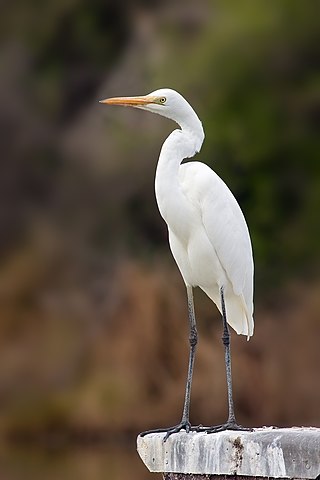
Egrets are herons, generally long-legged wading birds, that have white or buff plumage, developing fine plumes during the breeding season. Egrets are not a biologically distinct group from herons and have the same build.

Herons are long-legged, long-necked, freshwater and coastal birds in the family Ardeidae, with 72 recognised species, some of which are referred to as egrets or bitterns rather than herons. Members of the genera Botaurus and Ixobrychus are referred to as bitterns, and, together with the zigzag heron, or zigzag bittern, in the monotypic genus Zebrilus, form a monophyletic group within the Ardeidae. Egrets do not form a biologically distinct group from herons, and tend to be named differently because they are mainly white or have decorative plumes in breeding plumage. Herons, by evolutionary adaptation, have long beaks.

The great egret (Ardea alba), also known as the common egret, large egret, or great white egret or great white heron, is a large, widely distributed egret. The four subspecies are found in Asia, Africa, the Americas, and southern Europe. Recently, it has also been spreading to more northern areas of Europe. Distributed across most of the tropical and warmer temperate regions of the world, it builds tree nests in colonies close to water.

The little egret is a species of small heron in the family Ardeidae. It is a white bird with a slender black beak, long black legs and, in the western race, yellow feet. As an aquatic bird, it feeds in shallow water and on land, consuming a variety of small creatures. It breeds colonially, often with other species of water birds, making a platform nest of sticks in a tree, bush or reed bed. A clutch of three to five bluish-green eggs is laid and incubated by both parents for about three weeks. The young fledge at about six weeks of age.

The cattle egret (Bubulcus) is a cosmopolitan genus of heron found in the tropics, subtropics, and warm-temperate zones. According to the IOC bird list, it contains two species, the western cattle egret and the eastern cattle egret, although some authorities regard them as a single species. Despite the similarities in plumage to the egrets of the genus Egretta, it is more closely related to the herons of Ardea. Originally native to parts of Asia, Africa, and Europe, it has undergone a rapid expansion in its distribution and successfully colonised much of the rest of the world in the last century.

The western reef heron, also called the western reef egret, is a medium-sized heron found in southern Europe, Africa and parts of Asia. It has a mainly coastal distribution and occurs in several plumage forms: a slaty-grey plumage in which it can only be confused with the rather uncommon dark morph of the Little egret ; a white form which can look very similar to the little egret although the bill tends to be paler and larger and the black form with white throat E. g. gularis of West Africa. There are also differences in size, structure and foraging behaviour. There have been suggestions that the species hybridizes with the Little Egret, and based on this, some authors treat schistacea and gularis as subspecies of Egretta garzetta. Works that consider the Western Reef Heron as a valid species include the nominate gularis and schistacea as subspecies.

The white-faced heron also known as the white-fronted heron, and incorrectly as the grey heron, or blue crane, is a common bird throughout most of Australasia, including New Guinea, the islands of Torres Strait, Indonesia, New Zealand, and all but the driest areas of Australia.
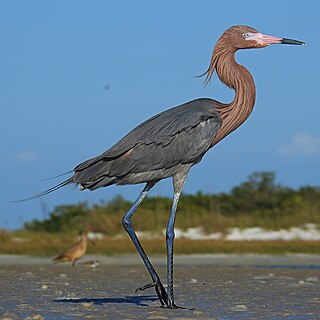
The reddish egret is a medium-sized heron that is a resident breeder in Central America, the Bahamas, the Caribbean, the Gulf Coast of the United States, and Mexico. The egret is known for its unusual foraging behavior compared to other herons as well as its association with mud flats, its habitat of choice.

The tricolored heron, formerly known as the Louisiana heron, is a small species of heron native to coastal parts of the Americas. The species is more solitary than other species of heron in the Americas and eats a diet consisting mostly of small fish.

The little blue heron is a small heron of the genus Egretta. It is a small, darkly colored heron with a two-toned bill. Juveniles are entirely white, bearing resemblance to the snowy egret. During the breeding season, adults develop different coloration on the head, legs, and feet.

The medium egret, median egret, smaller egret or intermediate egret, is a medium-sized heron. Some taxonomists put the species in the genus Egretta or Mesophoyx. It is a resident breeder in southern and eastern Asia.

The Royal Australasian Ornithologists Union (RAOU), now part of BirdLife Australia, was Australia's largest non-government, non-profit, bird conservation organisation. It was founded in 1901 to promote the study and conservation of the native bird species of Australia and adjacent regions, making it Australia's oldest national birding association. In 1996, the organisation adopted the trading name of Birds Australia for most public purposes, while retaining its original name for legal purposes and as the publisher of its journal, the Emu. In 2012, the RAOU merged with Bird Observation & Conservation Australia to form BirdLife Australia.

Mathoura is a small town in the Riverina region of southern New South Wales, Australia, in the Murray River Council local government area. At the 2016 census, Mathoura had a population of 938. At the 2021 census the population was 1,002.

The Malagasy pond heron, also known as the Madagascar pond heron or Madagascar squacco heron, is a species of heron of the family Ardeidae. They breed in Madagascar, Réunion and the Seychelles, and spend the non-breeding season in eastern mainland Africa. The population is estimated to number only 1,300–4,000 adults and the species is considered endangered.

Harriet Lawrence Hemenway (1858–1960) was a Boston socialite who cofounded the Massachusetts Audubon Society with Minna B. Hall. Hemenway was the wife of Augustus Hemenway.

The eastern great egret is a species of heron from the genus Ardea, usually considered a subspecies of the great egret. In New Zealand it is known as the white heron or by its Māori name kōtuku. It was first described by British ornithologist John Edward Gray in 1831.
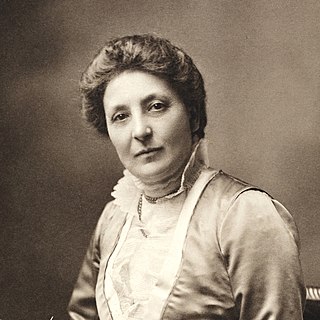
Margaretta "Etta" Louisa Lemon was an English bird conservationist and a founding member of what is now the Royal Society for the Protection of Birds (RSPB). She was born into an evangelical Christian family in Kent, and after her father's death she increasingly campaigned against the use of plumage in hatmaking which had led to billions of birds being killed for their feathers. She founded the Fur, Fin and Feather Folk with Eliza Phillips in Croydon in 1889, which two years later merged with Emily Williamson's Manchester-based Society for the Protection of Birds (SPB), also founded in 1889. The new organisation adopted the SPB title, and the constitution for the merged society was written by Frank Lemon, who became its legal adviser. Etta married Frank Lemon in 1892, and as Mrs Lemon she became the first honorary secretary of the SPB, a post she kept until 1904, when the society became the RSPB.
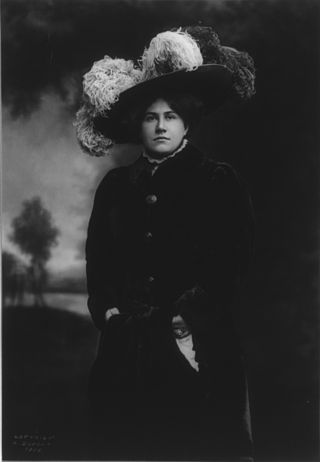
Plume hunting is the hunting of wild birds to harvest their feathers, especially the more decorative plumes which were sold for use as ornamentation, particularly in hat-making (millinery). The movement against the plume trade in the United Kingdom was led by Etta Lemon, Eliza Phillips, Emily Williamson, and other women and led to the establishment of the Royal Society for the Protection of Birds. The feather trade was at its height in the late 19th and was brought to an end in the early 20th century.
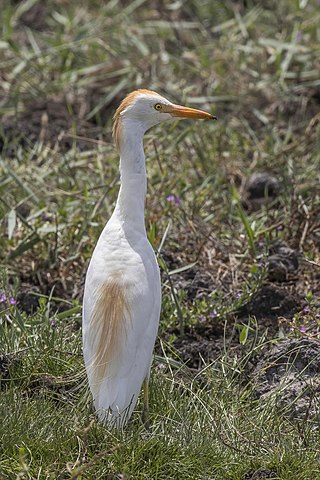
The western cattle egret is a species of heron found in the tropics, subtropics and warm temperate zones. Most taxonomic authorities lump this species and the eastern cattle egret together, but some separate them. Despite the similarities in plumage to the egrets of the genus Egretta, it is more closely related to the herons of Ardea. Originally native to parts of Asia, Africa and Europe, it has undergone a rapid expansion in its distribution and successfully colonised much of the rest of the world in the last century.

Mrs Pankhurst's Purple Feather: Fashion, Fury and Feminism – Women's Fight for Change is a 2018 book by Tessa Boase about Etta Lemon and her campaign against the use of feathers in hat-making (millinery) which led to the foundation of the Royal Society for the Protection of Birds. This campaign is compared and contrasted to Emmeline Pankhurst's campaign for women's suffrage in Britain, which it pre-dated. Ironically Etta Lemon was an anti-suffragist and anti-feminist.




















